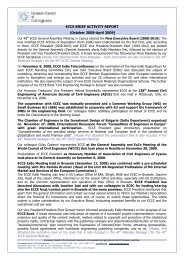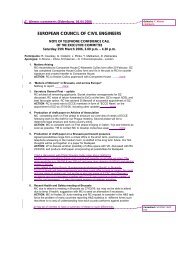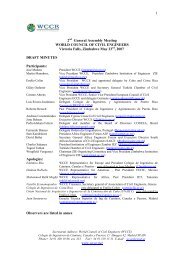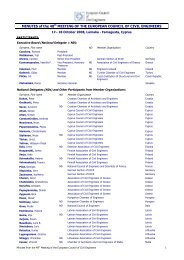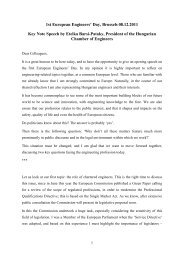A Closer Look at Prevailing Civil Engineering Practice - European ...
A Closer Look at Prevailing Civil Engineering Practice - European ...
A Closer Look at Prevailing Civil Engineering Practice - European ...
You also want an ePaper? Increase the reach of your titles
YUMPU automatically turns print PDFs into web optimized ePapers that Google loves.
A <strong>Closer</strong> <strong>Look</strong> <strong>at</strong> <strong>Prevailing</strong> <strong>Civil</strong> <strong>Engineering</strong> <strong>Practice</strong>, Wh<strong>at</strong>, Why and How<br />
Vincent T. H. CHU<br />
3. Some concrete specific<strong>at</strong>ion requires the testing of compressive<br />
strength for both 7 days and 28 days. Why<br />
7-day compressive strength test results are usually not used for<br />
acceptance purpose but for inform<strong>at</strong>ion only. Instead, 28-day compressive<br />
strength test results are commonly adopted for acceptance purpose.<br />
7-day compressive strength test results are often used to monitor the gain<br />
of early strength and they are estim<strong>at</strong>ed to be about 64% to 70% of the<br />
28-day strength. As such, it serves as a warning signal to both concrete<br />
producers and contractors should the 7-day compressive strength test<br />
results are far less than 75% of the 28-day strength. Nowadays, most<br />
concrete placement schedule are very tight and it is of paramount<br />
importance for contractors to get to know as soon as possible the<br />
occurrence of low 7-day compressive strength test results. As such, the<br />
contractor could implement suitable measures promptly to get better<br />
quality control procedures <strong>at</strong> construction site and to monitor closely on<br />
sampling, molding, and testing of the test cubes so as to avoid the<br />
recurrence of the production of low-strength concrete in the coming<br />
concrete b<strong>at</strong>ches.<br />
4. Wh<strong>at</strong> is the purpose of adding gypsum in cement<br />
Gypsum is a mineral and is hydr<strong>at</strong>ed calcium sulf<strong>at</strong>e in chemical form.<br />
Gypsum plays a very important role in controlling the r<strong>at</strong>e of hardening of<br />
the cement. During the cement manufacturing process, upon the cooling of<br />
clinker, a small amount of gypsum is introduced during the final grinding<br />
process.<br />
Gypsum is added to control the "setting of cement". If not added, the<br />
cement will set immedi<strong>at</strong>ely after mixing of w<strong>at</strong>er leaving no time for<br />
concrete placing.<br />
5. Wh<strong>at</strong> is the difference between release agent, form oils, form<br />
releaser, demoulding agent<br />
Release agent, form oils, form releaser and demoulding agent are<br />
m<strong>at</strong>erials for separ<strong>at</strong>ing formwork from hardened concrete. Though they<br />
generally refer to the same meaning, there are slight differences among<br />
these terms.<br />
15








